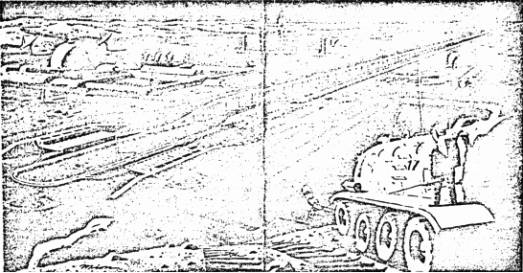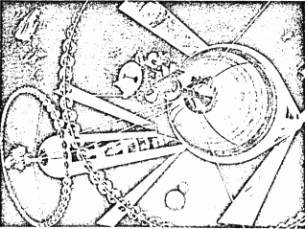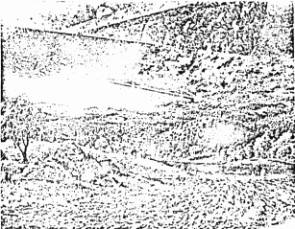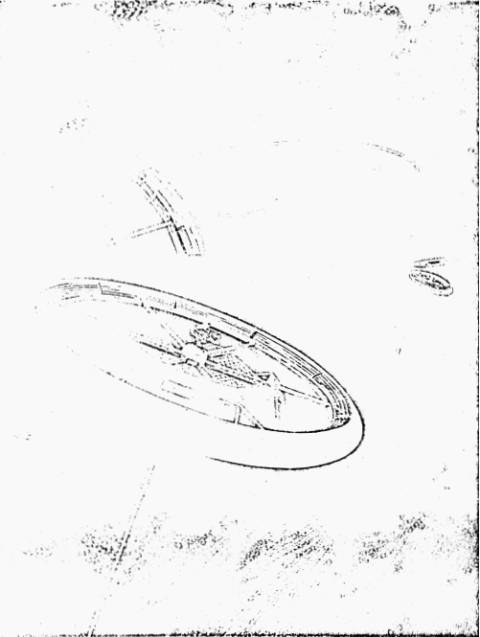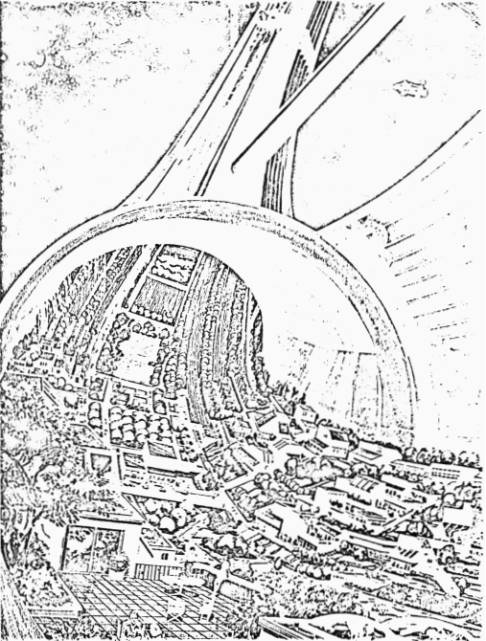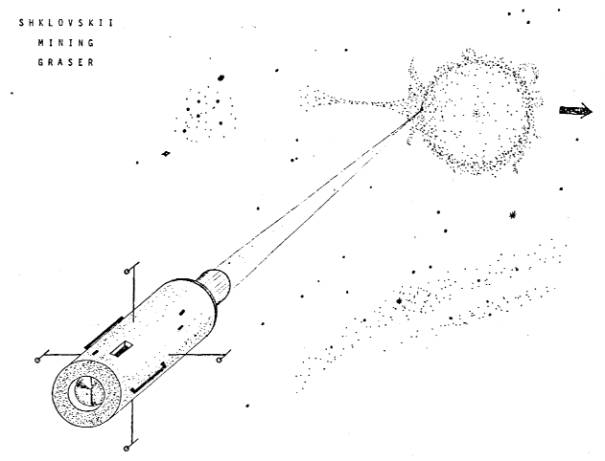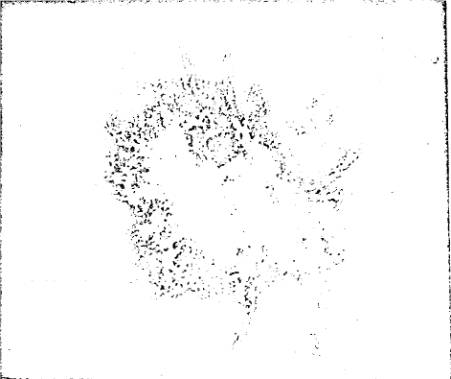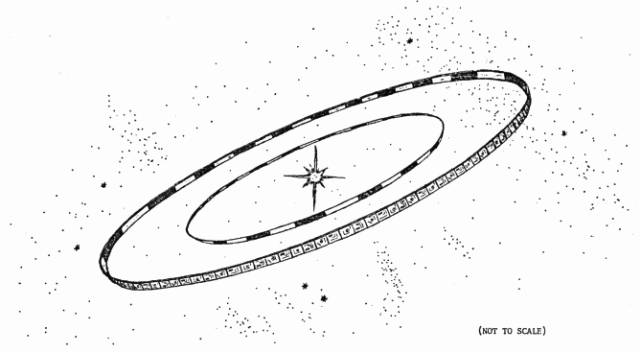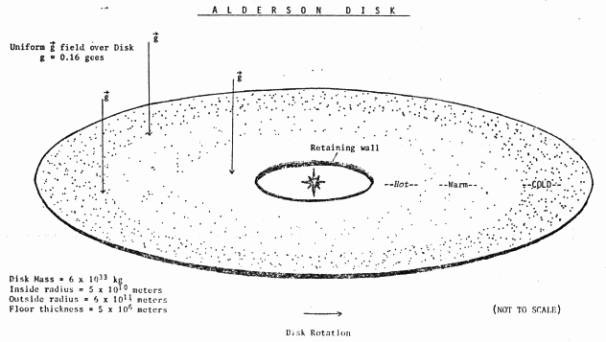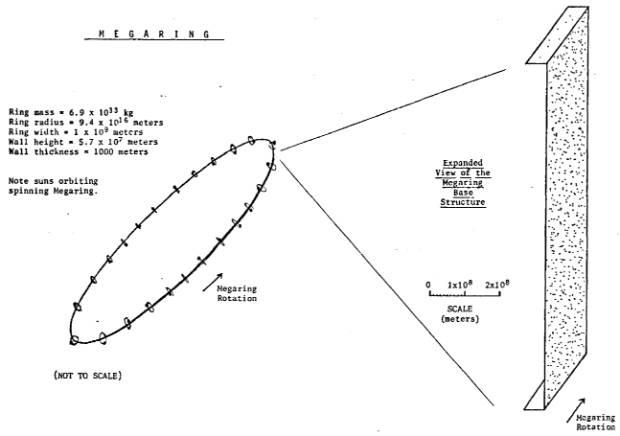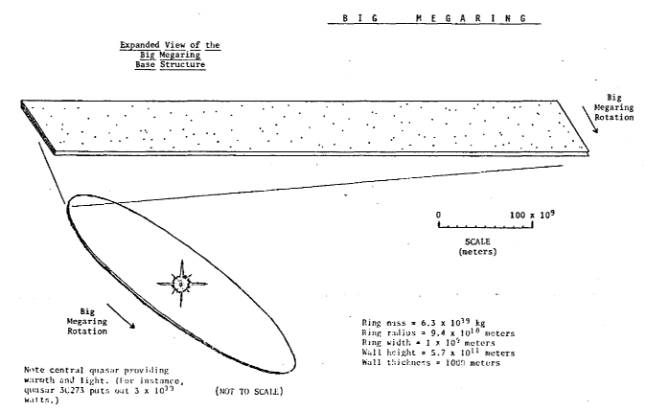19.2.1 Terraforming
If living space is in short supply on the home planet, one logical alter-native is to move some of the population and growth activities to other worlds. The typical habitable solar system will have from 7-13 planets and as many moons, but it is highly unlikely that more than one of these has a natural environment tolerable to interplanetary pioneers. As with Sol's family of worlds, most will be too hot or too cold or too dry or too wet to permit immediate habitation.
Terraforming is a form of planetary engineering on a grand scale. Just as buildings and cities are designed to suit human comfort, it is entirely feasible to consider the modification of planetary environments to suit human (or alien) needs.1977 Worlds which are unearthlike can be made more earthlike and may then be colonized and exploited by man.
There have been many proposals and suggestions as to how to go about terraforming the planets and moons of our own solar system. Only a few of these will be considered briefly here, because it turns out that in all cases the energy and mass requirements are well within the operating budgets of Type I planetary civilizations. In other words, from the point of view of a Type II culture terraforming techniques should represent a fairly primitive technology.
Perhaps inspired by Poul Anderson's short story entitled “The Big Rain,“ published in 1955, Dr. Carl Sagan in 1961 proposed a terraforming project to modify the environment of Venus.1481 Our sister planet has a hellish climate, with temperatures upwards of 750 °C and pressures of 90 atm at the surface. To prepare it for human habitation it will be necessary to lower the surface temperature and pressure, and to elevate by at least two orders of magnitude the fraction of molecular oxygen present in the atmosphere. Most of the air is carbon dioxide, and this must be eliminated as well.
Sagan suggests the injection of blue-green algae into the Venusian atmosphere at high altitudes where it is relatively cool. These tiny organisms would consume the CO2 by growing more algae cells with water and aerial nutrients. Molecular oxygen would be expired as a waste product. Over a period of several years the carbon dioxide level begins to drop, thus reducing the green-house effect and cooling the planet overall.2633 When the ground was sufficiently cool, cargo landers armed with fusion bombs could be de-orbited and set down on the surface. These machines, able to burrow like moles and detonate beneath the surface, may be used to trigger new volcanic chains in order to help percolate more water into the dry atmosphere.2836 Eventually the first “big rain“ will fall. Says Sagan: “The heat-retaining clouds will partly clear away, leaving an oxygen-rich atmosphere and a temperature cool enough to sustain hardy plants and animals from Earth.“
How reasonable is the astronomer's proposal? In 1970 a number of biologists conducted experiments to see if earthly algae would actually grow under the extreme initial conditions found on Venus.2847,2846 It was discovered that the most suitable strain is Cyanidium caldarium, a single-celled form that is found in hot springs on Earth. This algae produced oxygen vigorously in a hot, high-pressure atmosphere of CO2. In a typical experiment the researchers found that each million algae cells were increasing the oxygen concentration in the test tank by 380% per day.
To terraform the atmosphere of Venus is not a very difficult undertaking from the standpoint of energy and mass requirements. If we dispatch an armada of 500 seeding probes to our neighbor world, each armed with a thousand in-dependently-targetable payload capsules containing 1 ton of Cyanidium caldarium per capsule, this would result in the dispersal of a kilogram of living blue-green algae cells over each square kilometer of the planet's surface. The total mission mass is about 109 kg, and the total energy required is about 1018 joules -- both well within the budgetary limitations of a Type I civilization.
Small, airless terrestrial worlds such as Luna are also suitable for terraforming projects. Richard R. Vondrak of the Department of Space Physics and Astronomy at Rice University recently suggested a method for creating a comfortable artificial lunar atmosphere.656 The present lunar air has a total mass of about 10 tons. This arises mainly from outgassing from the interior, without which the entire atmosphere would quickly be swept away by the solar wind.
Vondrak calculates that if the atmosphere of the Moon was increased to a mass of at least 100,000 tons it would be driven into a “long-lived state“ which would drastically reduce losses to the solar wind. According to him:
If one wanted intentionally to create an artificial lunar atmosphere, gases can be obtained by heating or vaporization of the lunar soil. Approximately 25 megawatts are needed to produce 1 kg/sec of oxygen by soil vaporization. [Another] efficient mechanism for gas generation is subsurface mining with nuclear explosives. A 1-kiloton nuclear device will form a cavern approximately 40 meters in diameter from which 107 kg of oxygen can be recovered.656
To produce a breathable “shirtsleeve“ atmosphere, about 1018 kilograms of O2 must be pumped into the lunar environment. This should require a total energy expenditure of about 1024 joules. Again, both mass and energy figures lie within the budget of an ambitious mature Type I civilization.
A wide variety of Martian terraforming techniques have been proposed from time to time. Joseph A. Burns and Martin Harwit of the Center for Radiophysics and Space Research at Cornell University once speculated that the proper positioning of large masses in orbit around the planet would alter its equinoctal precession period.1282 This would cause a perpetual “Spring“ season planetwide, similar to that predicted by Sagan's "Long Winter" model of the Martian climate.1267
One scheme involves pushing Phobos from its present equatorial orbit to a new one inclined 45° to the Martian equator. The total energy required to exe cute this maneuver would be about 1023 joules. Unfortunately, Burns and Harwit admit, the orbit of Phobos would begin to precess and might foil the entire scheme. Their second proposal involves capturing roughly 25% of the matter in the nearby asteroid belt and using that mass instead of Phobos to swing Mars around. While this might work, at least two orders of magnitude of energy would be required.
Carl Sagan may have hit upon the cheapest way to terraform Mars.1288 He suggests that about 1010 tons of low albedo matter -- such as lampblack or dark-colored vegetation -- be transported to the permanent Martian polar icecaps over a period of about a century. The caps would be less reflective and would thus absorb more of the sun's energy. The ice would warm and thaw, increasing the atmospheric pressure (and the greenhouse effect) and speeding north-south convective stirring of the planetary atmosphere. A minimum of 1021 joules would be needed to accomplish this feat, and hundreds of years. There are ways to do it faster. An enormous orbiting mirror could be stationed in polar orbit to melt the icecaps by reflected or concentrated sunlight, or thermonuclear bombs could be set off to achieve similar effects perhaps in a matter of decades.1978
A more complete analysis was undertaken by a study group at NASA-Ames in 1976. Entitled On the Habitability of Mars: An Approach to Planetary Eco-synthesis, the final report of the study attempted to pin down the specific requirements for successful terraforming of the Red Planet.1926 It was concluded that “no fundamental limitation to the ability of Mars to support terrestrial life has been identified.“
The scientists proposed a two-pronged attack on the problem. First, atmospheric mass should be increased by vaporizing the polar icecaps or the subsurface permafrost. If the reflectivity of the icecaps was reduced by only 5% for a period of 100 years, a kind of runaway de-ice age might be triggered “and a new high temperature climatic regime established.“ Secondly, mechanisms of genetic engineering currently available or under development could be used to construct organisms far better adapted to grow on Mars than any present terrestrial organism. In principle, the entire gene pool of the Earth might be available for the construction of an ideally adapted oxygen-producing photosynthetic Martian organism.
It was estimated that the creation of an oxygen atmosphere using known terrestrial photosynthetic lifeforms might take hundreds of thousands of years. But by altering the environment of Mars and by seeding it with appropriately bioneered organisms, the length of time to project completion could be reduced a thousandfold. Total energy expenditure for the NASA-Ames scheme: Roughly 1024-1025 joules.
Academician N.N. Semenov, a Soviet scientist, suggests that the water locked in permafrost and polar icecaps by subjected to simple electrolysis.2849 Water molecules would be split into oxygen, which could be released into the Martian air eventually to result in a breathable atmosphere, and hydrogen, which could be collected and used for fuel in fusion power plants needed to operate the electrolysis factories. Earthlike air would result from the electrolysis of about 15% of all water believed to be present at the Martian surface, at a cost of about 1023 joules.
If water proves to be too scarce or too difficult to exploit, scientists are ready with the most grandiose scheme proposed to date. Saturn's rings are believed to consist primarily of flying chunks of water-ice. These icy boulders could be gathered together and welded into “a string of huge, frozen pearls, each the rival of Phobos.“2828 Properly outfitted with propulsion and automated guidance systems, the caravan of giant icebergs majestically peel away from Saturn in a long, steep dive sunward. What happens next has been eloquently described by Freeman Dyson:
A few years later, the night-time sky of Mars begins to glow bright with an incessant sparkle of small meteors. The infall continues day and night, only more visibly at night. Soft warm breezes blow over the land, and slowly warmth penetrates into the frozen ground. A few years later, it rains on Mars. It does not take long for the first oceans to begin to grow.2829
19.2.2 Space Habitats
While we may expect that Type II civilizations will certainly have the energy, mass, and technological sophistication to terraform virtually any terrestrial world in their system, the pressures of population expansion are not long alleviated by inhabiting other planets. Living area is increased by an order of magnitude at best, a bounty gobbled up in only 300 years assuming population expands at the modest rate of 1% per annum. And by staying on planets, the species condemns itself to a permanent Type I energy status.
The remedy to this dilemma is to build giant habitats in free space, far from the baleful encumbrances of planetary surfaces. In recent times Gerard K. O‘Neill and other have advocated the construction of enormous artificial habitats in Earth orbit (see especially Heppenheimer,2826 Johnson and Holbrow,2627 and O‘Neill2710) using materials lofted from the lunar surface by electromagnetic mass driver.2844 Preliminary estimates from several sources indicate that it is technically feasible to construct cities in space able to house 10,000 people and having a total mass of about 1010 kg. The main cost in energy comes from pitching the construction materials off the lunar surface. This cost amounts to about 1017 joules altogether. This is low enough to be feasible even for Type I civilizations such as our own -- provided we do not build too many of them. A Type II culture, of course, is rich enough to build all of them it wants.
After a sufficient number of habitats have been erected in space -- which O‘Neill calls Island One communities, the process of expansion would become self-sustaining. A group of Island One communities could pool their resources to form an economic cooperative, and engage in the construction of an even larger Island Two community. This monstrous edifice might be a giant, slowly-spinning cylinder perhaps 2 km in diameter and 6 km in length, housing a total of 140,000 people. The interior could be designed with a number of small villages separated by parkland or forest areas, each similar in size and population density to a small Italian hill town.2710
Still larger habitats could be built, since there is no gravity in free space to give engineers headaches. An Island Three community would measure more than 6 km in diameter and 32 km in length, with a total land area of 1300 square kilometers and a human population of several million persons. And, according to O‘Neill, structures up to four times larger are possible within the limits of current human technology. These Island Four communities would have land areas more than half the size of Switzerland, and populations numbering in the tens of millions (Figure 19.1).
The Stanford Torus Design2827
| |
|
Many scientists believe that it is wasteful to construct space cities out of lunar materials. It is cheaper, they claim, to use raw materials that are not trapped at the bottom of a gravity well. So, we mine the asteroids.2864 Dandridge Cole and Donald Cox showed in 1964 that hollow planetoid cities, similar in size and mass to the largest of the O‘Neill communities, could be constructed in a fairly straightforward manner.563
The first order of business is the erection of a giant solar mirror several kilometers in diameter.2848 Formed under conditions of zero gravity, it could have a very lightweight construction. Perhaps an old Echo balloon could be inflated, sprayed with a thin layer of something to harden it, then cut in half and silvered on the inside.
Next, an elongated asteroid should be selected, perhaps measuring a kilometer in diameter and two kilometers in length with a mass of about 1013 kg. The mirror is then used to bore out a hole down the central axis of the object. This is done by focusing the sun's rays on the mountain of nickel-iron and vaporizing away some of the metal. After it has cooled, the longitudinal hole is charged with large tankards of liquid water. The ends are securely plugged and welded shut using heat from the large mirror.
The planetoid is set spinning slowly around its long axis. The entire metal body is bathed in concentrated solar heat directed at its surface by the mirror. Gradually the temperature rises, finally reaching the melting point all over the surface. Slowly the heat creeps inward until virtually the entire object is molten or soft.
The central axis is the last place to melt if the procedures have been correctly executed. So long as this region remains solid, the melting body retains a cylindrical shape rather than coalescing into a formless spheroid. Just before the central region melts, the axial water tanks explode into super-heated steam. The immense pressure blows the asteroid into a giant nickel-iron balloon some 10 km in diameter and 20 km in length.
Once the hollow world has solidified and cooled off, construction crews affix the giant mirror to one end and direct solar power down the central axis to bring sunshine to the interior. Water, soil, and biology are now moved in. More than 780 km2 are available for habitation.
Life would be interesting inside a large O‘Neill community or Cole planetoid. The horizon, and landscape, rises overhead in the distance. Since only 3 km of air are required to appreciably scatter sunlight, the sky will be blue. If the planetoid is given a slight equatorial bulge and the endcaps are shaded from the sun, perpetual rain and snow will fall at the poles. The ice melt flows down rivers carved into the inside walls into a wraparound central circular lake that rises skyward in a beautiful blue arc at either horizon. Artificial spin-gravity may be set as low as desired, so it is possible to don a pair of wings and take to the air like birds.2429
19.2.3 Planet Moving and Star Mining
We are still thinking small, unfortunately.* We have not yet mentioned a single engineering project that could not be successfully mounted by a Type I planetary culture, at least in theory. A Type II society living in the space surrounding its sun will be a proud, vigorous, expansive large-scale civilization. They will have magnificent dreams, and their technology will not lag far behind their ambition.
A stellar culture will have access to the entire mass and derivable energy from all the matter in its own solar system. From Table 19.1 we have already seen that this represents considerable potential for energetic economic development of interplanetary space. Theoretically, a stellar society has at least 1030 kilograms and more than 1043 joules to play around with.
How grand may be their monuments to civilization? As even terrestrial engineers are well aware, any construction project has two basic requirements: (1) Delivery of materials to the construction site, and (2) proper deployment of those materials once they have arrived. So what can Type II cultures do?
While the technology needed to move planets and stars around is absolutely huge when measured against the normal human scale, the energy requirements for such operations turn out to be well within reach of Type II civilizations. Table 19.3 below shows the energies necessary to move several different kinds of bodies. Values are given both for solar escape velocity (~104 meter/sec) and for the minimum reasonable interstellar transport velocity (1%c).
Clearly, asteroid and planet-moving are no real problem. The interstellar transport of stars will give Type II societies some trouble, and it make take a Type III organization to perform the maneuver gracefully.
Darol Froman, Technical Associate Director of the Los Alamos Scientific Laboratory in New Mexico, has pointed out that the complete fusion combustion of all the deuterium in Earth's oceans would be insufficient to impart solar escape velocity to the planet.2831 If the hotter-burning hydrogen fusion reactions are used, however, Earth's seas could be drained and used as fuel to propel our world to the stars.
Froman suggests that roughly a quarter of the fuel be used to escape from Sol, another quarter to enter the target stellar system many light-years away, and the remaining half for heat, lighting, and propulsion en route. The planetary fusion thrusters should be located at the South Pole, so that Earth's natural rotation can be used for guidance and directional stabilization. Science fiction writer Stanley Schmidt has done a creditable job in describing the local effects of terramotive operations.2832
How might gas giants be pushed around the solar system? We know Type II societies have the energy, but what kind of technology might be involved? In one of his science fiction tales of the distant future, Larry Niven describes how it might be possible to use what he calls a Fusion Pogo Rocket. A tremendous fusion motor hooked up to a reworked military laser cannon might turn the trick on our Uranus:
It's a double-walled tube, very strong under expansion shock. It floats vertical in the upper air. Vents at the bottom let in the air, which is hydrogen and methane and ammonia, hydrogen compounds, like the air that the sun burns. You fire laser cannon up along the axis, using a color hydrogen won‘t let through. You get a fusion explosion along the axis, and the explosion goes out and up. The whole mass blasts out the top, through the flared end. It has to have an exhaust velocity way higher than Uranus's escape velocity. The motor goes smashing down into deeper air. You see there's a kind of flared skirt at the bottom. The deep air builds up there at terrific pressure, stops the tube and blasts it back up. You fire it again... The atmosphere is fuel and shock absorber both -- and the planet is mostly atmosphere.2636
Stars, too, may be moved about, using a tuned Shklovskii Mining Graser (see below) at reduced power. This powerful gamma-ray laser could be aimed to strike a glancing blow at the target star on the side opposite the direction you want it to move. The sun will spew out star-stuff and begin to move off in the direction dictated by Newton's laws of motion. Scientists agree that this technique may work, because the same basic principle of propulsion has been observed to occur naturally with comets. These “dirty snowballs,“ swinging close to our Sol, are heated on the sunward side. Material boils off asymnietrically and jets out into space, deflecting the orbit by a kind of rocket effect.**
So delivery of the materials to the construction site is no problem for stellar cultures. What about deployment? Once a planet or star has been moved to where it is needed, how do we get the mass out?
One of the most popular techniques for taking planets apart is called centrifugal disruption. This requires the accelerated rotation of a planet up to the point at which it fractures under internal stresses. Slowly the world unravels, sloughing off outer layers like a successive molting. If the speed-up is continued long enough, the entire body will be disrupted into asteroid-sized chunks of mass.
Freeman Dyson has suggested that centrifugal disruption could be accomplished by laying a net of conductive windings around a planet along the lines of latitude, each strand carrying a current on the order of microamperes per square centimeter.1450 These cables would give rise to a magnetic field. Orbiting electrical generators (which produce an opposing magnetic field) then trace out paths which produce a net torque on the body, causing it to spin faster. A continuous stream of generators must pass through the correct maneuvers to maintain the electromagnetic accelerative force, each unit converting its orbital momentum into planetary spin momentum. An alternative disruption technique is available to civilizations that have mastered fusion power -- simple tangential reaction thrust generated by sideways-firing equatorial fusion rockets would also spin up a world to destruction.2833
When the rotation rate of a planet the size of Earth has been brought up to about 100 minutes per revolution, says Dyson, “the equator is just ready to take off into space. From this point on, the process of disassembling the planet will proceed steadily as its angular momentum is increased.“ The total energy required to spin Earth up to the transition point is about 4 x 1030 joules; for Jupiter, about 9 x 1034 joules will be necessary. (After 97% of Jupiter's mass has been stripped away, we are left with a large terrestrial world that was once the core of the jovian -- a mass of from 5-10 Earth-masses. We may decide to cannibalize it for heavy metals, or it may be saved for reasons of aesthetics, nostalgia, or terraforming and habitation operations.)
J.H. Fremlin and Anthony Michaelis have suggested that gas giants could be disassembled bit by bit.2955 Suborbital fusion satellites and nuclear ram-scoops could dip down into the jovian atmosphere, scoop up some hydrogen, fuse it into heavier elements, and use the resulting energy to propel the transmuted matter into a parking orbit near the construction site. The energy needed to move Jupiter's entire mass into an Earth parking orbit along a minimum energy transfer trajectory is about 1036 joules.
Still a third possibility is Explosive Disruption. Theoretically, with enough energy under harness any planetary body can quite literally be blasted into rubble. While we don‘t know what kind of explosive device might be used (perhaps a 6-km-wide antimatter asteroid?), it is a simple matter to calculate how much energy would be required. The total energy to disrupt a world expIosively is on the order of its gravitational potential energy. This works out to about 2 x 1032 joules for Earth and 2 x 1036 joules for Jupiter. Again, no problem at all for Type II cultures.
In a related manner, stars too may be disassembled. The energy required to blow a sun to bits by brute force explosive disruption is about 2 x 1041 joules, which would be quite a challenge for an enterprising stellar society. But this is not very elegant. The renowned Soviet astrophysicist Iosef S. Shklovskii has considered the possibility that an artificial supernova might be induced in a single star.20 Shklovskii believes that a Type II civilization should have no difficulty constructing a gigantic gamma-ray laser (or “graser“) operating at a wavelength of 1 Angstrom and at power levels of at least 1015 watts. This Mining Graser (Figure 19.2) would have a forward aperture diameter of about 10 meters and could focus on a 10-km-wide spot at a star's surface from a safe distance of 10 light-years. (Unmanned automated devices can venture closer.) The Mining Graser will probably be “self-critical“ -- that is, an enormous nuclear reactor that emits most of its laser energy directly as coherent light.284)
Figure 19.2 The Shklovskii Mining Graser
ABOVE: the Shklovskii Mining Graser strikes a glancing blow to an alien sun, causing it to move off in the opposite direction due to the rocket effect.
BELOW: the graser beam is cranked up to maximum power and directed straight at the star. The remnants of the resulting supernovae might appear as the Crab Nebula does in this photograph.
According to an astrophysical theory proposed by British astronomer Geoffrey Burbidge, a concentrated gamma-ray flux should cause exceedingly high temperatures to arise in the outer layers of a star. If this temperature was hot enough, a spontaneous supernova might result. It is estimated that a flux of 107 watts/m2 may be sufficient to initiate a supernova explosion.2837
When this occurred, perhaps 0.1% of the star's mass would be converted directly into energy -- about 1043 joules. In addition to the release of copious amounts of x-rays and other radiative energy that could be collected and stored, a significant fraction of the stellar mass will be propelled outward at speeds up to 1000 km/sec. This rich expanding gas cloud may be harvested by diligent interstellar mining engineers, using squadrons of robot drones equipped with giant electromagnetic ramscoops. Heavy elements generated by the explosion would be swept up, refined and milled by a flotilla of gargantuan factory sweepships in a "cage" of circular orbits surrounding the demolished star.
The Shklovskii Mining Graser can also be used to turn stars off. The beam strikes a glancing blow first on one side, then the other, and so forth. Star-stuff spews equally from either side, so the sun goes nowhere. Sweepships collect and store the unburned stellar hydrogen as it streams from the photo-sphere. Slowly the star is whittled down to size as the bulk of its mass is siphoned off and taken away. Finally, down to less than 1% of its original weight, the once-mighty celestial furnace flickers out. The hot jovian planet that remains may now be disassembled by the more conventional means discussed earlier.
* A sobering example of this appears in Isaac Asimov's Foundation Trilogy.2944 Trantor, the Imperial capitol of all the Galaxy, is described as a giant ecumenopolis, a “planetary city“ of gleaming metal covering 190 million km2 (about the surface area of Mars) and extending nearly 2 km deep. There are 40 billion human bureaucratic inhabitants. This seems a rather impressive piece of architecture, especially since each person would have a generous 107 m3 all to himself which is at least two orders of magnitude more room than most people have on Earth today. But the mass and energy requirements are far less impressive. If made of steel the total mass of the city of Trantor would come to about 1019 kg. Only a million average-sized asteroids need be captured for this purpose, and only about 1026 joules would be required to transfer them to the site of construction -- say, Earth orbit. (This is the major energy cost of the project.) So mighty Trantor, pride of the Galactic Imperium and capitol world of the entire Milky Way, could be constructed with some difficulty by a mature Type I civilization or with ease by a Type II civilization.
** Galaxy-moving should be possible for Type III civilizations using a related technique. Synchronized application of the Graser to a few percent of the stars in a galaxy would cause billions of suns to move off in the preferred direction. The rest of the galaxy, bound to the moving stars by gravity, would slowly follow.
19.2.4 Large Scale Biospheric Engineering
Assuming a Type II civilization can find all the materials and energy it may require, normal expansive development and material growth may proceed. As it matures, the stellar culture may place more and more artifacts in solar orbit in an attempt to soak up every last joule of the sun's output. They may not want to go to the trouble of turning their star off, or they may lack the technological acumen to do it, or they may find the idea unethical, unnatural, and morally repugnant.
So while it is not inevitable, the chances are good that at least some extraterrestrial Type II cultures wish to preserve their sun in its natural state. On the basis of this assumption, Freeman Dyson predicted more than twenty years ago that the end result of interplanetary industrialization may be a shell of artifacts completely encasing the star. Seen from a great distance this "Dyson Sphere" would radiate only waste heat at a wavelength of about 10 jim in the deep infrared.1022
Theoretically, a normal solar system should have plenty of mass with which to construct a solid Dyson Sphere around a star. (At least one writer has likened this to "a ping pong ball with a star in the middle."673) If the entire planetary mass of Sol's system was spread into a solid shell at the radius of Earth's orbit, the resulting artifact would run a bit less than 10 meters thick. The interior surface area would be the equivalent of a billion Earths, about three hundred million billion square kilometers of habitable land.
There are a number of mechanical difficulties associated with the solid Dyson Sphere. If rotating, the equatorial section would bow outward due to centrifugal force. Similarly, the "poles" would lack support and flatten, causing dynamic instability and collapse of the structure. If stationary, solar tidal forces would give rise to large compressive stresses.* The shell seems too thin to maintain proper rigidity. Furthermore, the gravity on the outer surface would be only 0.6 milligees so no reasonable atmosphere could be held. Objects or gases or people living on the inside would fall gently into the sun. There have been many attempts to save the Sphere by positing antigravity devices at critical points along the surface, but these heroic efforts remain unconvincing. For a Type II society, at least, a solid Dyson sphere is out of the question.
Anyway, the Square-Cube Law predicts that we'll get more square meters of living area out of each kilogram of building materials used if we construct the smallest habitable structures possible. For this reason, Dyson himself proposed that the Sphere should be comprised of swarms of relatively small space habitats. If we use Cole Planetoids equipped with large, very thin solar collector mirrors, we could build about 1014 of them interior to Earth's orbit. Each would weigh about 1013 kg, and could be pressurized with a breathable oxygen atmosphere. If they were constructed with a doubling time of 25 years, only 1200 years would be required to complete the transition to a mature Type II stellar industrial civilization.
Larry Niven has come up with a fascinating alternative to the Dyson Sphere. His proposal: A giant Ringworld (Figure 19.3), a great ribbon of matter shaped like a hoop with the same diameter as Earth's orbit.753 The great structure whirls around the sun at 1240 km/sec to provide a constant 1-gee gravity across the Ring. If the entire planetary mass of our solar system was used, the Ringworld would measure about 1000 meters thick. At last -- a project truly worthy of a stellar culture.
Figure 19.3 The Niven Ringworld753
Ring mass = 2.5 x 1027 kg
Radius = 1.5 x 1011 meters (1 AU)
Wall height = 2 x 106 meters
Floor thickness = 1000 meters
Walls 2000 kilometers high at either edge of the Ringworld ribbon, aiming toward the central star, would be enough to hold in most of the atmosphere. An inner ring of shadow squares -- orbiting panels to block out parts of the sunlight -- provide a day/night cycle for Ringworld inhabitants. By bobbing the structure up and down, the apparent angle of the sun changes and we get seasons. You could even see the stars, as well as a beautiful checkered arc, traversing the nighttime sky.
The interior surface area would be equivalent to three million Earths, and the artifact would require on the order of 1036 joules to assemble -- a project well within reach of a Type II civilization. The engineering effort would necessarily be a massive one. Looking at the outer surface of the Ringworld, Niven says:
Seas would show as bulges, mountains as dents. Riverbeds and river deltas would be sculptured in; there would be no room for erosion on something as thin as a Ringworld. Seas would be flat-bottomed -- as we use only the top of a sea anyway -- and small, with convoluted shore lines. Lots of beachfront. Mountains would exist only for scenery and recreation. A large meteor would be a disaster on such a structure. A hole in the floor of the Ringworld, if not plugged, would eventually let all the air out, and the pressure differential would cause storms the size of a world, making repairs difficult.673
More than one Ringworld could circle a sun, although this would require additional mass borrowed either from the local star or from a neighboring system. Many different intelligent races could wrap noncoplanar Ringworlds around the same star, with differing radii to avoid collision and provide a variety of temperature regimes.
There is also the possibility of harnessing the basic Ringworld structure for interstellar travel on a massive scale. Niven elaborates:
The Ringworld rotates at 1240 km/sec. Given appropriate conducting surfaces, this rotation could set up enormous magnetic effects. These could be used to control the burning of the sun, to cause it to fire off a jet of gas along the Ringworld axis of rotation. The sun be-comes its own rocket. The Ringworld follows, tethered by gravity. By the time we run out of sun, the Ring is moving through space at Bussard ramjet velocities. We continue to use the magnetic effect to pinch the interstellar gas into a fusion flame, which now becomes our sun and our motive power.673
Pat Gunkel has designed a structure analogous to the Ring but of considerably lower mass. Imagine a strand of hollow metal macaroni, about a trillion meters long but only a kilometer or two in cross-sectional diameter and a few hundred meters thick. Gunkel joins the two ends together in a great hoop around the sun, sets it rotating in smoke ring fashion to get artificial gravity on the inner surface, and calls it Topopolis.673 With a complete artificial biosphere set up inside, and solar collectors set up outside for energy, this huge tunnel world would have a habitable surface area of only about 20 Earths. But each one we make costs us only about 3 x 1027 joules and weighs only about one-thousandth as much as the Earth.
So far we've discussed projects for Type II civilizations. Let's have a look at a few designs that will require the muscle of a galactic Type III civilization.
Dr. Daniel Alderson proposes a massive structure shaped like a giant phonograph record with the star in the center hole (Figure 19.4). Gravity will be uniform and perpendicular to the Disk everywhere except at the edges. A slow spin should partially counteract the sideways inward pull of the central star and provide a stable celestial pole. A 1000-km-high retaining wall should be constructed on the lip of the inner hole, to prevent the leakage of atmosphere into the sun.673
Figure 19.4 The Alderson Disk673
Disk Mass = 6 x 1033 kg
Inside radius = 5 x 1010 meters
Outside raduis = 6 x 1011 meters
Floor thickness = 5 x 106 meters
Uniform g field over Disk; g = 0.16 gees
The Alderson Disk (see illustration previous page) weighs in at about 6 x 1033 kg, or about 3000 solar masses. The innermost radius is about 50 million kilometers, just inside the orbit of Mercury; the outermost radius is set at 600 million kilometers from the sun, about midway between the asteroid belt and Jupiter. The Disk is 5000 km thick, so the surface gravity is 0.14 gees (about like Luna). If the air is pressurized to 1 atm at the surface, then the total weight of the atmosphere is only 2 x 1029 kg, less than one-tenth of a solar mass extra. Since gravity is so low, the air thins out very slowly with altitude: 40 kilometers up, the pressure is only down to 0.5 atm which is still breathable. Also, note that both sides of the artifact can be inhabited.
Since the Disk is far more massive than the central star, the sun should be bobbled up and down to create seasons. Computer-controlled Shklovskii Grasers mounted on the inside edge could induce vertical motion, and would also serve to nudge the star back to center if it begins to stray towards the inside annular edge of the Disk. The energy required to assemble the Alderson Disk should be about 5 x 1044 joules, which should be fairly trivial for a galactic culture.
One science fiction writer waxes enthusiastic about the idea:
The Disc would be a wonderful place to stage a Gothic or a sword-and-sorcery novel. The atmosphere is right, and there are real monsters. Consider: We can occupy only a part of the Disc the right distance from the sun. We might as well share the Disc and the cost of its construction with aliens from hotter or colder climes. Mercurians and Venusians nearer the sun, Martians out toward the rim, aliens from other stars living wherever it suits them best. Over the tens of thousands of years, mutations and adaptations would migrate across the sparsely settled borders. If civilization should fall, things could get eerie and interesting.673
Due to its size, the Alderson Disk would probably have to be a cooperative venture of a group of Type II cultures (perhaps 10-100 of them) or of a single emergent Type III galactic civilization. The additional land area made avail-able is enormous. The useful living surface would be the equivalent of more than 4 billion Earths.
The value of large-scale economic cooperation is fairly obvious. Perhaps, in view of this, we should take a second look at the solid Dyson Sphere concept. Is it possible for a galactic community to build one?
Probably. It will be recalled that the main problem, other than simple lack of mass, was the matter of dynamical instability. Even if the hollow sphere was rotated fast enough to support the equatorial zone of the structure against collapse, the polar regions would fall in and destroy the Sphere. Veteran science fictioneers Jack Williamson and Frederick Pohl pondered the problem and came up with a most ingenious, workable solution. Here, in their own words, is how it's done:
Surround the star with several layers of ring-shaped tubes. The tubes themselves are stationary, but they contain a heavy, low-viscosity fluid flowing fast enough to create the centrifugal force required to support the tubes and loads above them. One set of parallel tubes holds up the “equator“ -- which isn‘t really moving -- and other sets, tilted at suitable angles, support the regions near the “poles.“ The tubes are also heat engines, with the fluid driven by energy absorbed from the sun and flowing through generator stations which supply power to all the inhabited levels. Master computers adjust the velocity of flow to fit the loads.2834
The Sphere is massive -- about 15 solar masses. The shell is equivalent to a wall of solid steel more than 3 km thick, but since much of the room is taken up by living quarters, passageways and so forth, the hull is actually more than 60 km deep. The total energy needed to assemble the Sphere would probably run on the order of 1043 joules, but to propel it through space at 17%c (the stated velocity) will require an additional 4 x 1046 joules of energy.
Though the surface gravity is only 1% that of Earth, this is still enough to hold a tenuous atmosphere just above the external armor plating. Part of this is interstellar gas, but most of it is a helium-oxygen mixture left over from nuclear power plants which use water for fuel. The oxy-helium air is just barely breathable at the lower altitudes, with predictable consequences:
The outer surface was at first an endless plain of bare metal, but much of it is now covered with soil from accumulated cosmic dust and the industrial wastes dumped from the occupied levels. Plant life has evolved there, supported by the energy-flow from below through a process of thermosynthesis. These plants are often luminescent, so that vast landscapes glow with varied color. There's animal life, adapted to the low gravity and to varied local conditions of light or darkness, heat or cold, wild storms or unending calm -- with no rotation and no external sun. Most of these beings evolved on the surface, but some are migrants from below. A few are human.2834
* This may not be fatal to the project. According to equations for gravitational tidal stress on large structures provided by Dyson,1450 the minimum materials strength needed to hold a solid Dyson Sphere together should be no more than 1012 N/m2. Flawless diamond has a theoretical maximum compression strength of ~1012 N/m2 and shearing strength ~1011 N/m2 so it may be possible to work something out.2838 At compressions above 1011 N/m2, the normally colorless diamond takes on a delicate light brown color.2939
19.2.5 Galactic Megastructures
What kinds of projects would really tax the abilities of a Type III civilization? Galactic cooperation among literally billions of worlds will permit construction on a scale never before dreamt of by mankind. From our limited terrestrial perspective, there is no way that we can easily imagine the technical skills of a race which commands nearly twenty five orders of magnitude more energy than we. Nor can we imagine the legitimate rationale, if any exists, for building such massive architectures. Fortunately, we can make a few educated guesses what might be possible based solely on the limitations of finite energy and mass resources. No matter how big and how powerful, every culture has its limits.
A good example of a galactic megastructure which humans have no idea how to build is the Megaring (Figure 19.5). Megaring is a mammoth ringworld stretching twenty light-years in diameter. The flat habitable surface is a million kilometers wide, with 60,000-km-high atmospheric retaining walls at the edges. The surface gravity of 1 milligee is slightly augmented by the 0.03 milligee acceleration caused by the rotation of the artifact: Megaring rotates at 10%c.
The air pressure at the base of the Megaring floor is a normal 1 atm, and falls to 0.5 atm only at a height of 6000 kilometers. A man weighing 70 kg on Earth would weigh 70 grams on Megaring. If he could jump 1 meter on Earth, he can leap at least a kilometer on Megaring -- and it will take him 7½ minutes to come back down. Still more fascinating, the gravity is low enough and the air thick enough that mankind could fulfill one of its oldest and dearest dreams: A human being could take to the air from a standing start and fly as a bird, simply by flapping his arms like wings. And he could soar literally thousands of kilometers high.
Ring mass = 6.9 x 1033 kg
Ring radius = 9.4 x 1016 meters
Ring width = 1 x 109 meters
Wall height = 5.7 x 107 meters
Wall thickness = 1000 meters
Perhaps not surprisingly, most of the mass of the Megaring is air. About 330 solar masses are used in the structural frame, which is then filled with 3130 solar masses of atmosphere. The ring itself constitutes a mere 3% of the total system weight. Most of the mass -- some 126,000 solar masses worth -- consists of non-disassembled stars. More than a hundred thousand suns circle the Megaring in helical orbits at a distance of 1 AU. (More accurately, the ring orbits the stars and so must be extremely flexible -- but let's not quibble about dynamics.) Held in place by graser assemblies or powerful magnetic fields, this circulating stellar bucket brigade provides Megaring inhabitants with warmth and illumination.
The total energy cost of this project is somewhere in the neighborhood of 1045-1046 joules, really a modest price for a galactic culture to pay for such an exotic habitat with a livable surface area of more than a trillion Earths. Of course, we don‘t know how to build a Megaring. But the mass and energy bills are well under budget. If Want truly overcomes Big and Costly, and if the expenditure of resources in building this artifact can be ethically justified (Chapter 25), then somewhere in this universe someone may have built such an artifact.
Leaving aside all considerations of ethical energy use, and considering only mass-energy consumption and ignoring structural and construction details, still grander projects are possible in principle, but they will sorely strain the resources of a single Type III civilization. The Big Megaring (Figure 19.6) is a ringworld a thousand light-years in radius, spinning majestically at 10%c along the circumference. Due to the extremely low floor gravity (measured in tens of microgees), the breathable atmosphere doesn‘t drop to half-pressure for many tens of millions of kilometers. As a result, the basic shape of the habitat changes. Rather than a thin ribbon, the Big Megaring more closely resembles the outer section of a very thin canister of movie film -- a kind of hollowed-out Alderson disk, 600 million kilometers wide and a million kilometers deep with kilometer-thick walls.
Ring mass = 6.3 x 1039 kg
Ring radius = 9.4 x 1018 meters
Ring width = 1 x 109 meters
Wall height = 5.7 x 1011 meters
Wall thickness = 1000 meters
Again, the mass of the air predominates. The Big Megaring structure takes only 34 million solar masses, but 3 billion solar masses of air are needed to provide 1 atm base pressure. The estimated assembly energy is 1051 joules, not counting the quasar which has been moved to the center for heat and light. While the construction of the Big Megaring seems a vast undertaking indeed, a galactic culture will have both the mass and the energy to do the job. There may be quite sound reasons for designing a gigantic space habitat which affords a living area equivalent to 130,000 trillion Earths or more than 240 million Dyson Spheres.
An even bigger artifact is the Megadisk, a scaled up version of the Alderson Disk. The radius of the central hole is 1 light-year, and the distance to the outer edge is 10 light-years. The design is that of a “floppy disk“ configuration, as the base structure is only 100 kilometers thick. The total weight is 11 galactic masses (1MG = 3 x 1041 kg), of which 10 are in the Megadisk frame and 1 is air. This provides a 1 atm pressure on both sides of the disk. The energy to assemble this beast is about 1054 joules, so a consortium of Type III civilizations could probably handle the assignment. (There may be political problems in obtaining the 11 MG. Attempting to exercise eminent domain over eleven galaxies cannot be an easy job.) The Megadisk would provide a living area equivalent to 1020 Earths or nearly a thousand Big Megarings.
The Megasphere is probably the ultimate in biosphere engineering. It is a Dyson Sphere 200 light-years in diameter, with a surface area of more than 130,000 square light-years. The surface gravity is measured in milligees, and the air pressure falls to half about 6500 kilometers from the surface. The base structure is 10 kilometers thick, and both sides are equally habitable.
The Megasphere is far beyond the resources of Type III civilizations. About 1300 galactic masses are needed as raw materials, and 1056 joules are required for initial assembly. Over a billion year span of time, another 1056 joules must be expended simply to maintain the Megasphere at a comfortable 25 ºC. The bill for upkeep is staggering. Only an emergent Type IV universal civilization would dare such an incredible feat.*
* In theory, larger structures are possible. For instance, a 2000-light-year-diameter Big Megasphere could be constructed with 4000 galactic masses and a thickness of 1 kilometer. However, if the air pressure at the surface is more than 0.01 atm (about like Mars), the Big Megasphere is smaller than its Schwartzchild radius and thus becomes a black hole. This should not adversely affect its habitability. However, all journeys to it will be one-way unless tachyonic propulsion is available.
